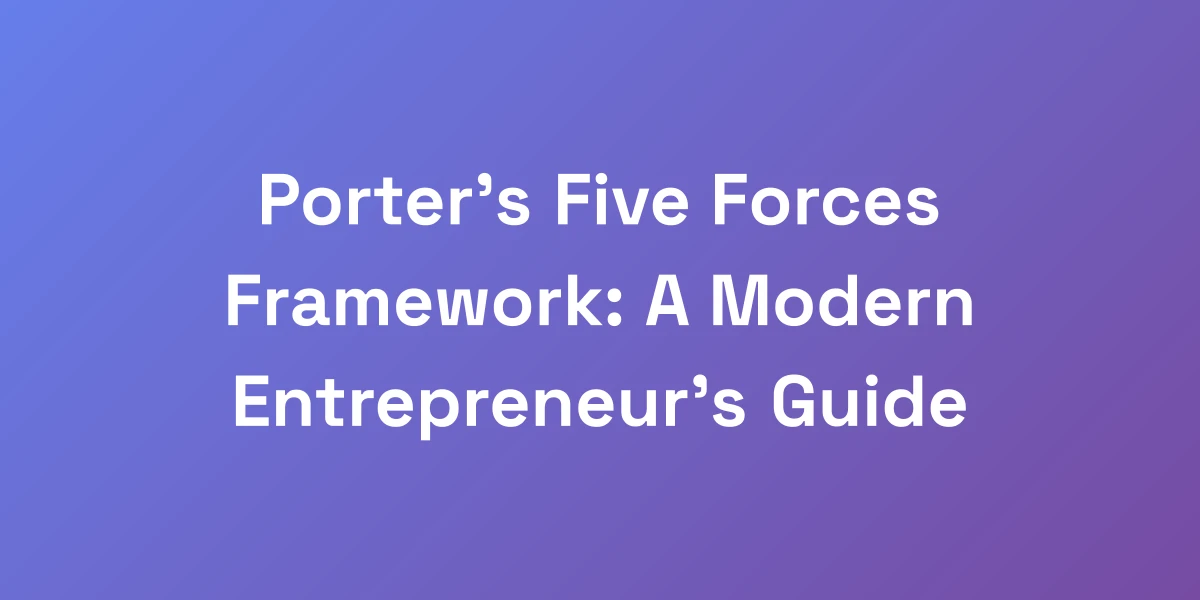
Porter’s Five Forces Analysis: 5 Mind-Blowing Industry Examples
Apr 8, 2025 | By [email protected]
Let me hit you with some truth: most businesses fail because they don’t understand their competitive landscape. I’ve seen countless entrepreneurs throw money at problems without first mapping out their battlefield.
Porter’s Five Forces isn’t just some dusty academic framework – it’s a powerful weapon that’s helped us identify golden opportunities and avoid costly mistakes.
When you grasp these five forces, you’re not just playing the game – you’re controlling it. Let’s break down how the world’s smartest business leaders use this tool to dominate their markets.
Understanding Porter’s Five Forces: The Million-Dollar Framework
Porter’s Five Forces is more than just a tool; it’s a strategic lens through which we can view the complexities of any industry. Imagine having a microscope that not only magnifies but also dissects the various elements that influence your business landscape.
Why settle for surface-level insights when you can delve deeper and truly understand the dynamics at play?
The Genesis of Porter’s Five Forces
Developed by Michael E. Porter in 1979, the Five Forces framework was born out of a need to understand the competitive pressures that shape every market. Porter identified five key forces that determine the intensity of competition and, ultimately, the profitability of an industry.
This framework has stood the test of time, evolving alongside industries and adapting to modern challenges. Whether you’re in tech, retail, or manufacturing, Porter’s Five Forces provides a robust foundation for strategic analysis.
Why Traditional Competition Analysis Falls Short
Traditional competition analysis often focuses narrowly on direct competitors, missing out on broader factors that can impact your business. It’s like trying to win a race by only paying attention to the runner in front of you while ignoring the terrain and weather conditions.
Porter’s Five Forces expands the scope, considering suppliers, buyers, potential entrants, and substitutes. This holistic approach ensures that no stone is left unturned in understanding the true competitive landscape.
The Strategic Advantage of Force-Based Thinking
Adopting a force-based mindset equips us with the ability to anticipate changes and pivot strategies effectively. For instance, if we recognize that buyer power is increasing, we can take proactive steps to enhance customer loyalty or diversify our customer base.
This strategic foresight is what sets successful companies apart from those that merely survive. By continuously assessing these forces, we stay ahead of the curve and maintain a competitive edge.
Modern Applications in Digital Markets
The digital age has transformed how we apply Porter’s Five Forces. Take e-commerce, for example. The barriers to entry are lower, but so is customer loyalty. Platforms like Amazon leverage network effects to dominate, making it crucial to understand these modern dynamics.
Digital markets also introduce new substitutes and alter supplier relationships, requiring us to revisit and adapt our strategies continually.
Common Implementation Mistakes to Avoid
Understanding Porter’s Five Forces is one thing, but implementing it effectively is another. A common mistake is treating it as a one-time analysis rather than a continuous process. Markets are dynamic, and so should be our analysis.
Another pitfall is ignoring the interconnections between the forces. For example, the rise of new entrants can influence both competitive rivalry and buyer power, creating a ripple effect across the entire framework.
To avoid these mistakes, embed the Five Forces analysis into your regular strategic planning cycle and ensure a holistic view of all the forces at play.
Tesla’s Dominance: A Five Forces Masterclass
Here’s the thing about Tesla that most people miss: they’re not just winning because of their technology. Elon Musk orchestrated a perfect storm of competitive advantages using every single force in Porter’s framework.
They’ve built such high barriers to entry that even century-old automakers are struggling to catch up. When you understand how Tesla manipulated these forces, you’ll see why they’re not just another car company – they’re a force multiplier in the automotive industry.
Supplier Power: Tesla’s Vertical Integration Strategy
Tesla takes supplier relationships to another level with its vertical integration strategy. By owning key parts of their supply chain, Tesla reduces dependency on external suppliers, mitigating risks associated with supplier power.
For example, Tesla manufactures its own batteries through Gigafactories, which not only ensures a steady supply but also reduces costs through economies of scale. This strategic move significantly lowers supplier bargaining power, allowing Tesla more control over pricing and quality.
Buyer Power: Creating a Cult-Like Following
Buyer power is another area where Tesla excels. They’ve cultivated a cult-like following, transforming customers into brand advocates. This loyalty diminishes buyer power because customers are less likely to switch to competitors.
Additionally, Tesla’s direct-to-consumer sales model eliminates middlemen, providing a seamless buying experience that enhances customer satisfaction and loyalty. This strategic focus on customer experience lessens the influence buyers have over price negotiations.
Competitive Rivalry: Rewriting Industry Rules
In an industry dominated by legacy automakers, Tesla rewrites the rules of competition. By prioritizing innovation and sustainability, Tesla sets itself apart from traditional rivals.
Their aggressive push into electric vehicles forces other automakers to accelerate their own EV plans, intensifying competitive rivalry. However, Tesla’s first-mover advantage and continuous innovation keep them ahead of the curve, making it difficult for competitors to match their pace.
New Entrant Threats: Building Unscalable Moats
Tesla creates high barriers to entry through significant capital investment and technological advancements. Their extensive network of Superchargers and proprietary technology act as moats that new entrants find hard to replicate.
Moreover, Tesla’s strong brand and market presence deter new players from entering the electric vehicle market, further solidifying their dominant position.
Substitute Products: Making Alternatives Obsolete
By continuously innovating, Tesla makes substitute products less attractive. Their advancements in battery technology and autonomous driving capabilities set new standards, making alternative options seem outdated.
Tesla’s focus on creating superior products ensures that substitutes struggle to compete on the same level, thereby protecting their market share and profitability.
Amazon’s Marketplace: Crushing It Through Five Forces
Amazon isn’t just winning – they’re systematically eliminating competition through a masterful understanding of Porter’s framework. Think about it: every move Bezos made was calculated to strengthen their position across all five forces.
From Prime membership to AWS, they’ve created an ecosystem so powerful that competing with Amazon is like fighting a war on five fronts. Let me show you exactly how they’ve engineered their dominance.
Leveraging Network Effects
Amazon leverages network effects to enhance its marketplace’s value exponentially. The more sellers and buyers on the platform, the more attractive it becomes to new users, creating a virtuous cycle of growth.
This interconnectedness reduces the threat of new entrants and substitutes because the platform becomes indispensable for both buyers and sellers. It’s a strategic move that locks in users and increases dependency on Amazon’s ecosystem.
Prime’s Role in Customer Lock-in
Amazon Prime is a brilliant example of using buyer power to create customer lock-in. With benefits like free shipping, exclusive deals, and streaming services, Prime membership increases customer loyalty.
These incentives make customers less likely to shop elsewhere, effectively reducing buyer power by tethering customers to Amazon’s ecosystem. Prime is not just a subscription; it’s a strategic tool for maintaining a steady revenue stream and customer base.
Supplier Relationships and FBA
Amazon’s relationship with suppliers is another critical aspect of their dominance. Through Fulfillment by Amazon (FBA), they offer sellers streamlined logistics and storage solutions, making it easier for them to scale.
By providing these services, Amazon strengthens its supplier ecosystem while also increasing its bargaining power. Suppliers become reliant on Amazon’s platform, which in turn reduces their ability to negotiate terms, consolidating Amazon’s control over the marketplace.
Technology Barriers and AWS
Amazon Web Services (AWS) is not just a revenue powerhouse; it’s a strategic asset that reinforces Amazon’s position across all five forces.
By offering scalable and reliable cloud services, AWS creates high technology barriers to entry. Competitors face significant challenges trying to match the technological infrastructure and capabilities that AWS provides, reinforcing Amazon’s dominance in the tech space.
Cross-Industry Expansion Strategy
Amazon’s foray into various industries, from cloud computing to entertainment, diversifies their revenue streams and reduces vulnerability to competitive pressures in any single sector.
This cross-industry expansion dilutes competitive rivalry and makes it harder for any one competitor to challenge Amazon’s overarching dominance. By being present in multiple sectors, Amazon ensures multiple touchpoints with consumers, increasing their overall market influence.
Netflix’s Strategic Evolution Through Porter’s Lens
Netflix’s transformation from DVD rental to streaming giant is a textbook example of using Porter’s Five Forces to predict and adapt to market changes.
They saw the writing on the wall and completely restructured their business model to dominate the new digital landscape. Their content strategy isn’t just about making good shows – it’s about systematically eliminating competitive threats before they materialize.
Content Creation as a Defensive Strategy
Netflix’s investment in original content serves as a defensive strategy against competitors and substitutes. By producing exclusive shows and movies, Netflix reduces the threat of substitutes because viewers have no other place to watch this content.
This strategy not only differentiates Netflix from other streaming services but also builds a loyal subscriber base that values unique content. The continuous creation of high-quality content keeps customers engaged and less likely to switch to rival platforms.
Streaming Wars and Competitive Dynamics
The streaming industry is akin to a battlefield, with major players like Amazon Prime, Disney+, and HBO Max vying for dominance. Netflix navigates this intense competitive rivalry by constantly innovating and expanding its offerings.
By analyzing competitive dynamics, Netflix can identify gaps in the market and respond swiftly, whether by acquiring popular content or entering new markets. This agility allows Netflix to stay ahead in the streaming wars, maintaining its position as a leader.
Technology Infrastructure Advantages
Netflix’s robust technology infrastructure is a cornerstone of its success. Their advanced recommendation algorithms personalize the user experience, making it easier for subscribers to find content they love.
Additionally, Netflix invests heavily in streaming technology to ensure high-quality, uninterrupted service, which enhances user satisfaction and retention. This technological edge creates a significant barrier to entry for new competitors who may struggle to match Netflix’s seamless streaming experience.
International Market Adaptation
Netflix’s strategic focus on international markets has been pivotal in its global dominance. By adapting content to local tastes and investing in region-specific productions, Netflix caters to diverse audiences worldwide.
This localization strategy not only broadens Netflix’s subscriber base but also reduces the threat of local competitors. By understanding and addressing the unique preferences of different regions, Netflix strengthens its presence globally, making it harder for new entrants to penetrate these markets.
Future-Proofing Against New Threats
Netflix stays ahead by anticipating and preparing for future threats. Whether it’s the rise of new streaming platforms or changes in consumer behavior, Netflix’s proactive approach ensures they are well-positioned to navigate emerging challenges.
By continuously evolving their content strategy and technology investments, Netflix minimizes the impact of potential threats, ensuring sustained growth and market leadership.
Implementing Porter’s Analysis in Your Business
Here’s the brutal truth: knowing the framework isn’t enough – you need to know how to weaponize it in your specific market.
We’re going to show you the exact process we use with our clients to turn Porter’s Five Forces from a theoretical model into a money-printing machine. This isn’t about creating pretty PowerPoint slides – it’s about making actionable strategies that will 10x your market position.
Step-by-Step Analysis Framework
Begin by identifying the five forces in your industry: competitive rivalry, threat of new entrants, bargaining power of suppliers, bargaining power of buyers, and threat of substitutes.
Next, assess each force by analyzing factors such as the number of competitors, entry barriers, supplier concentration, and customer loyalty.
Finally, develop strategies to mitigate weak points and leverage strengths identified through the analysis.
- Competitive Rivalry: Identify key competitors and analyze their strengths and weaknesses.
- Threat of New Entrants: Assess the ease of entry for new players and identify ways to create higher barriers.
- Bargaining Power of Suppliers: Evaluate the number and power of your suppliers and explore ways to diversify your supply chain.
- Bargaining Power of Buyers: Understand customer needs and improve loyalty through superior service and value.
- Threat of Substitutes: Identify potential substitutes and innovate to make your products or services a preferred choice.
Data Collection and Market Research
Accurate data is the backbone of a successful Five Forces analysis. Gather comprehensive market data, including white label SEO reports, competitor financials, and consumer behavior studies.
Utilize both primary and secondary research methods to ensure you have a well-rounded understanding of the market dynamics.
- Primary Research: Conduct surveys, interviews, and focus groups to gain firsthand insights.
- Secondary Research: Leverage existing reports, articles, and databases to gather additional information.
Force Prioritization Strategy
Not all forces are created equal. Prioritize the forces based on their impact on your business. For instance, in a highly competitive industry, competitive rivalry might be your top priority.
Focus your resources on addressing the most significant forces first to maximize strategic impact.
- High Impact Forces: Allocate substantial resources to mitigate their effects.
- Low Impact Forces: Monitor these forces but prioritize less resource-intensive strategies.
Action Plan Development
Translate your analysis into actionable strategies. Develop a detailed action plan that outlines steps to leverage strengths and address weaknesses identified through the Five Forces analysis.
- Strengths: Enhance and capitalize on existing strengths to gain a competitive edge.
- Weaknesses: Implement strategies to overcome or mitigate weaknesses.
- Opportunities: Identify and exploit market opportunities revealed by the analysis.
- Threats: Develop contingency plans to address potential threats.
Monitoring and Adjustment Protocols
Porter’s Five Forces analysis is not a one-time task. Establish monitoring protocols to continuously assess the market and adjust your strategies accordingly.
Use key performance indicators (KPIs) to track the effectiveness of your strategies and make data-driven adjustments as needed.
- Regular Reviews: Conduct periodic reviews of your Five Forces analysis to stay updated on market changes.
- Data-Driven Decisions: Use real-time data to inform strategic adjustments and ensure ongoing relevance.
Conclusion
Porter’s Five Forces is more than a framework; it’s a strategic powerhouse that can transform your understanding of the competitive landscape.
By applying this analysis, we’ve seen how industry giants like Tesla, Amazon, and Netflix dominate their markets by strategically leveraging each of the five forces.
Now, it’s your turn to weaponize this framework and elevate your business to new heights.
Ready to take control of your market? Start implementing Porter’s Five Forces today and watch your competitive advantage grow.
Have questions or success stories using Porter’s Five Forces? Drop a comment below and let’s engage!








